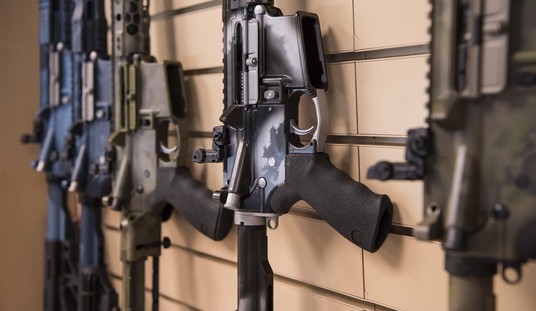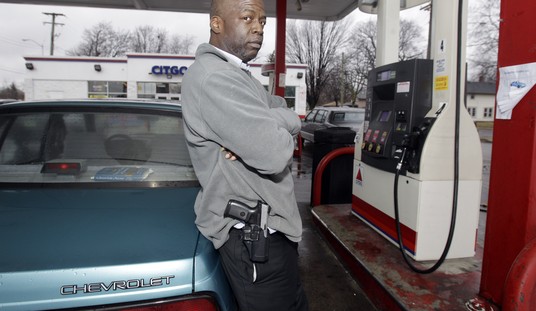Oh, dear. It seems that the American Political Science Review did a lousy job of refereeing a pseudo-academic study, Cross-Border Spillover: U.S. Gun Laws and Violence in Mexico.
The study was brought to us by Joshua Keating from Slate, which is merely guilty of being a hack e-zine.
Keating’s article is primarily the result of an uninformed reporter assuming that academics in soft social sciences actually engage in more than bias-reinforcing navel-gazing. Put bluntly, he doesn’t have the background to write intelligently about the subject, which is sadly a common truth for most journalists. Keating’s inability to do more than parrot what he’d like to believe is merely exacerbated by the inflammatory image chosen to accompany the article.

While the article purports to be about firearms banned as part of the so-called “Assault Weapons Ban” that was part of the 1994 Crime Bill, the image chosen to illustrate the article is of a selective-fire M4 carbine and under-barrel M203 40mm grenade launcher, two military weapons not remotely regulated under the law in question and never available for sale without extensive federal background checks from specially-licensed dealers to heavily-regulated consumers. Regulated under the National Firearms Act, legally purchased selective-fire assault rifles like the M4 shown have not been used in a single murder in the history of the United States.
Whether this image was chosen out of incompetence or malice is largely irrelevant, but given the e-zine’s general disdain of the Second Amendment, it isn’t unfair to assume that the misrepresentation is a conscious effort to misinform their low-information readers.
Once we get to the actual content of the Slate article, we get to the meat of the problem, which is the conclusion reached by a trio of inept academic researchers:
A recent study published in the American Political Science Review attempts to measure the impact of U.S. gun laws on Mexican violence by exploiting an interesting natural political experiment. When the 10-year U.S. assault weapon ban expired in 2004, the selling of assault rifles became legal in the border states of Texas, Arizona, and New Mexico, but not California, which had a pre-existing state-level ban. Authors Arindrajit Dube of the University of Massachusetts and Oeindrila Dube and Omar Garcia-Ponce of NYU looked at whether violence increased more in areas of Mexico near border states that were selling these weapons.
Unfortunately for Keating and the authors of the study, the entire premise of the research drew from the false assumption that the production and and sale of firearms labeled “assault weapons” decreased or ceased between 1994 and 2004.
Nothing could be further from the truth. For starters, it was never illegal to buy, sell, or possess firearms “banned” under the 1994 law.
In addition, production of these firearms didn’t appreciably slow down, and in fact increased for some manufacturers during the life of the law.
All the 1994 “ban” actually did was ban some firearms by name, and others by cosmetic features.
Names of firearms banned by name—which are nothing more than marketing terms—were changed.
Banned cosmetic features—which have no bearing on how guns function—were removed, and production lines continued manufacturing these same firearms, with only slight modifications to bring them in compliance with the law.
How futile was the effort? Let’s look at two examples.
The Colt AR-15 and the Intratec TEC-9 were two of the firearms “banned” by name by the Violent Crime Control and Law Enforcement Act of 1994.
Here is a photo of the Colt AR-15 banned by name during the 10 years of the 1994 “ban.”
It is a 5.56 caliber semi-automatic magazine-fed rifle, typically fed from 20- or 30-round magazines.
Note that this model has a flash hider and a bayonet lug. A flash hider has a simple purpose; it redirects the burning gas leaving the muzzle so that it more fully combusts, so that it does not interfere as much with the sight picture of the shooter. The bayonet lug is simply an attachment point for bayonets.
Here is the Colt HBAR target rifle, sold during the entire life of the “ban.”

It is a 5.56 caliber semi-automatic magazine-fed rifle, typically fed from 20- or 30-round magazines.
It’s hard to tell the two apart, isn’t it? That’s because the Colt AR-15 and Colt HBAR are—in every way that matters—the exact same rifle. The only significant changes are the cosmetic removal of the bayonet lug from the bottom of the front sight post, and the removal of the flash hider. They use the same ammunition, same magazines, have the same range, and same rate of fire. All the so-called “ban” did was cause the manufacturer to remove two minor cosmetic features and change the product name.
The production line never stopped, and availability of these firearms on store shelves—including those in Texas, Arizona, and New Mexico,—never significantly decreased. The same is true for all manufacturers of AR-pattern rifles.
The history of the TEC-9, also banned by name under this legislation, reveals a similar story.
The TEC-9 on the left was banned as an assault weapon. Before the law even went into effect, the manufacturer, Intratec, released the firearm on the right, the snark-laced AB-10, where “AB” was a flippant jibe that meant “after ban.” In this case, the barrel shroud was removed and the muzzle was no longer threaded to accept flash hiders. A barrel shroud only serves to keep the shooter from touching a hot barrel after it has been fired repeatedly, and does not affect the accuracy, range, or rate of fire of the firearm.
Like the Colt—and indeed, almost every firearm “banned” under the ill-conceived and ineffectual law—Intratec changed their firearm’s banned cosmetic feature and continued production unabated, until the low perceived quality of the gun drove the company out of business in 2001.
Whatever violence that happened in Mexico after 2004 was not affected one way or the other by the sunset of the ineffective 1994 Assault Weapon ban, which was ineffectual in this nation, and Mexico as well.
Correlation—and in this instance a false correlation—is not causation. Arindrajit Dube, of the University of Massachusetts Amherst, along with Oeinbrila Dube, and Omar Garcia-Ponce of New York University are the authors of this study, and simply failed to do their due diligence as researchers.
Bad policy makes bad science makes bad policy.
Slate and American Political Science Review both obviously have a lot to learn, and if American Political Science Review would like to retain their credibility, they’ll retract this “study” immediately.










Join the conversation as a VIP Member